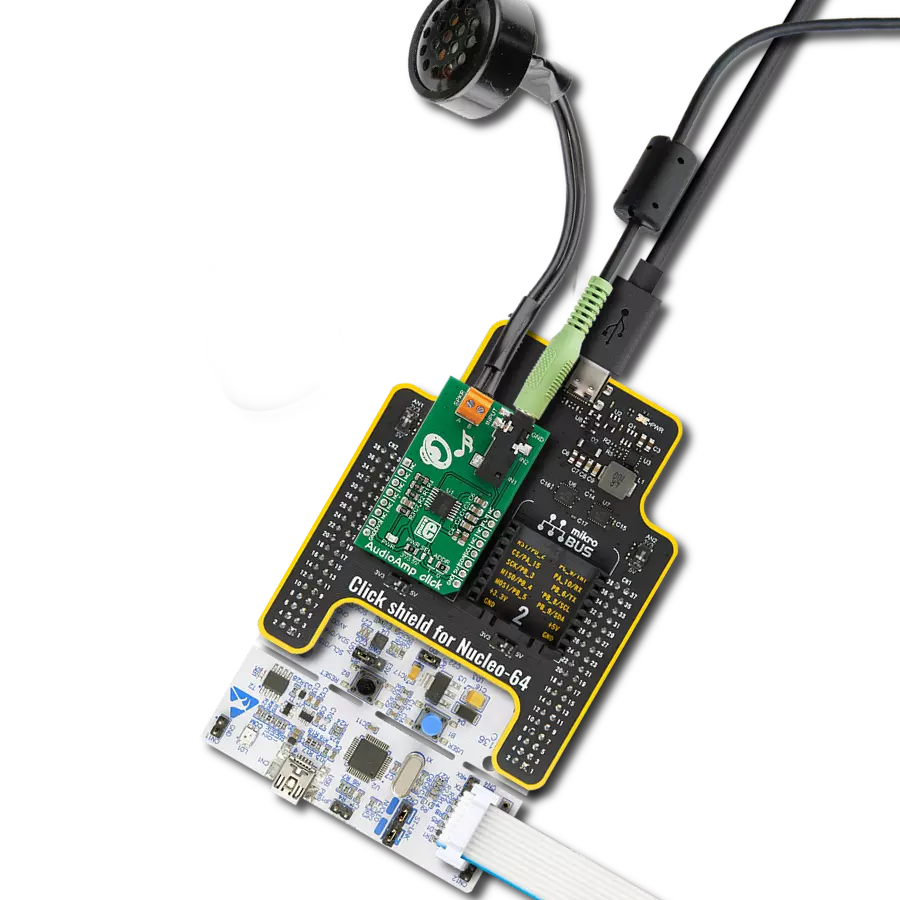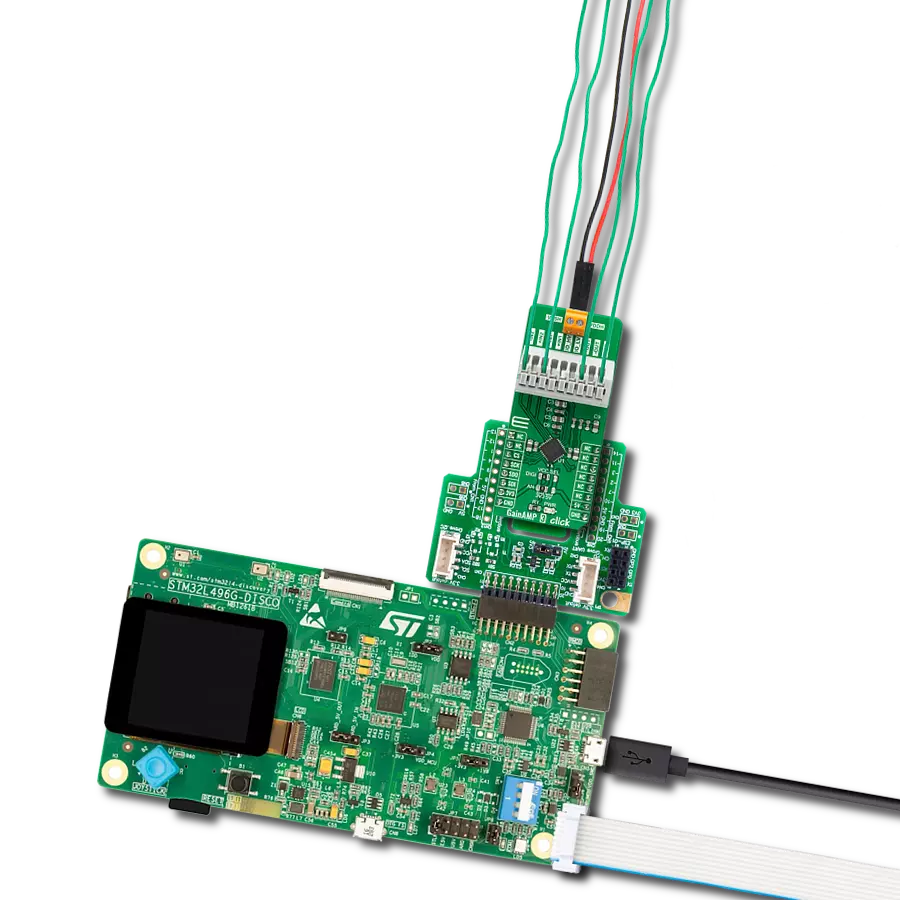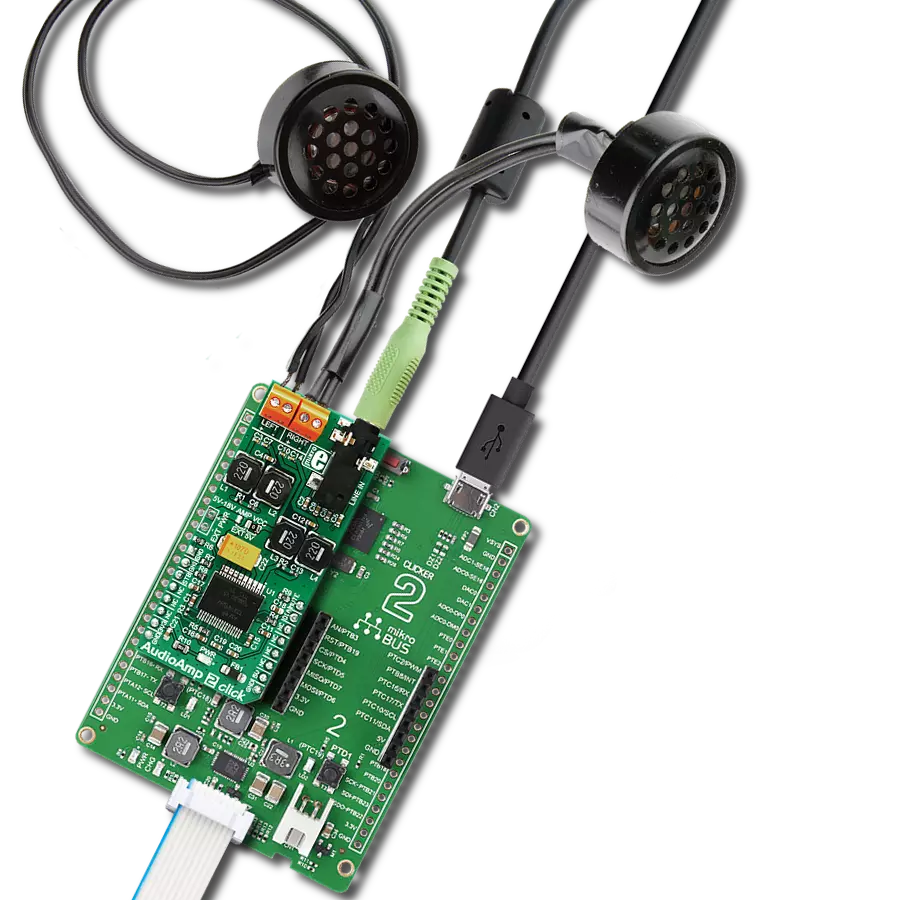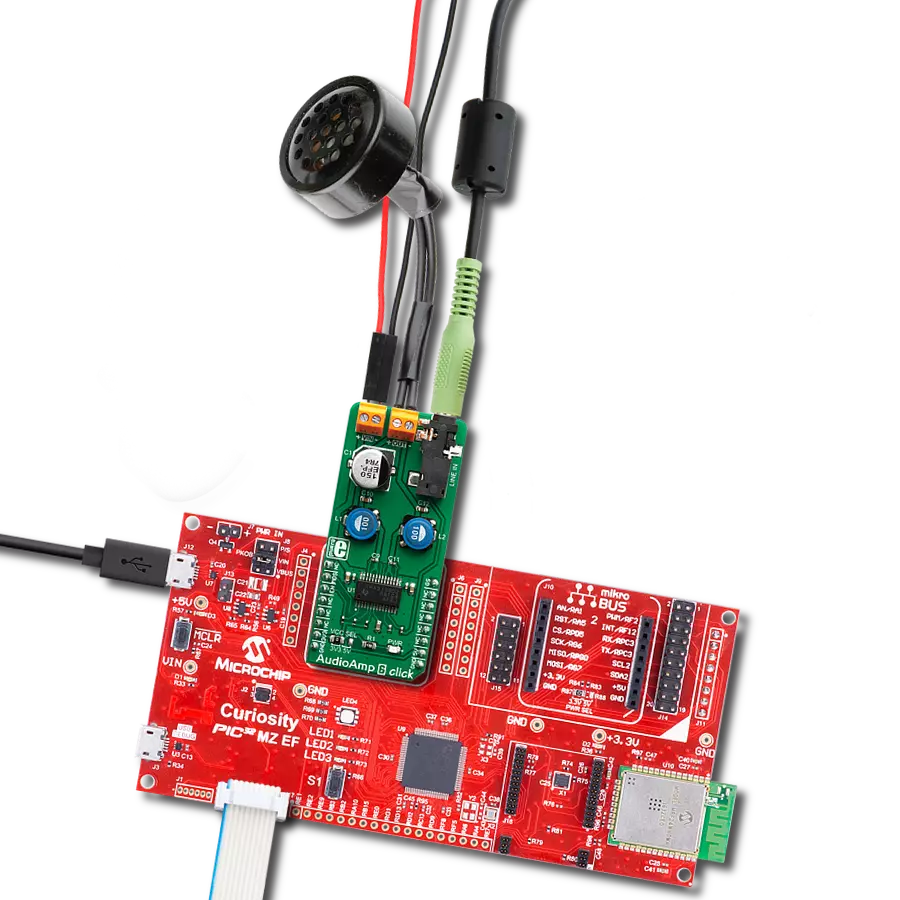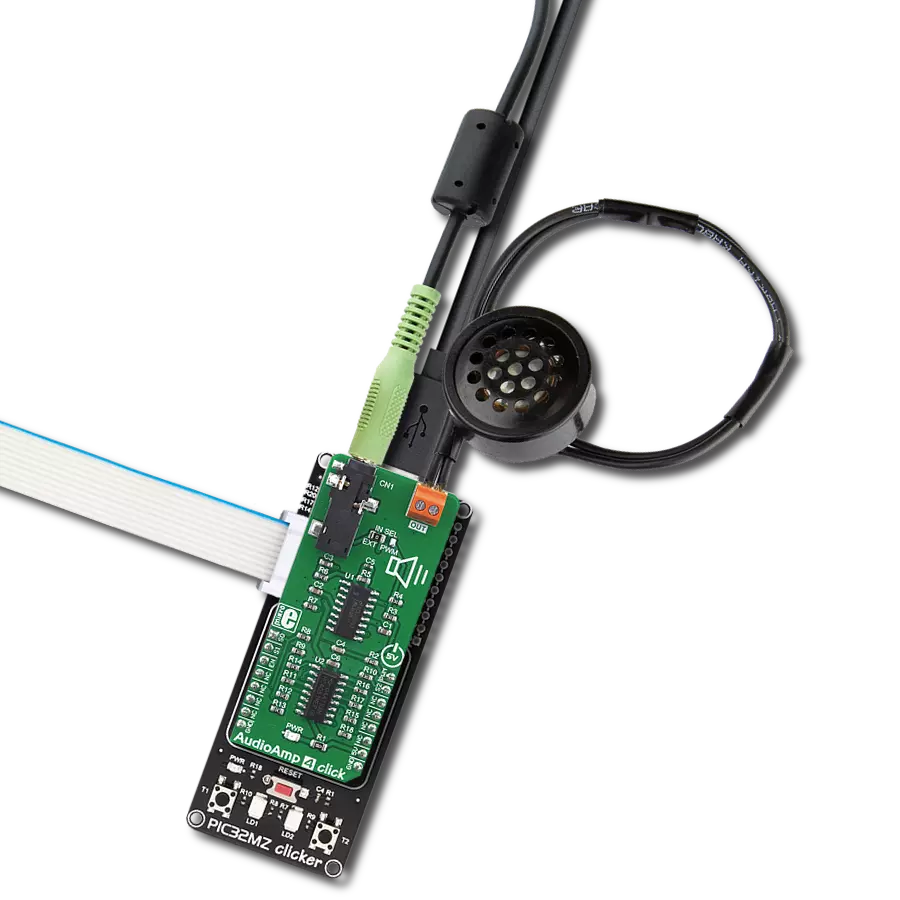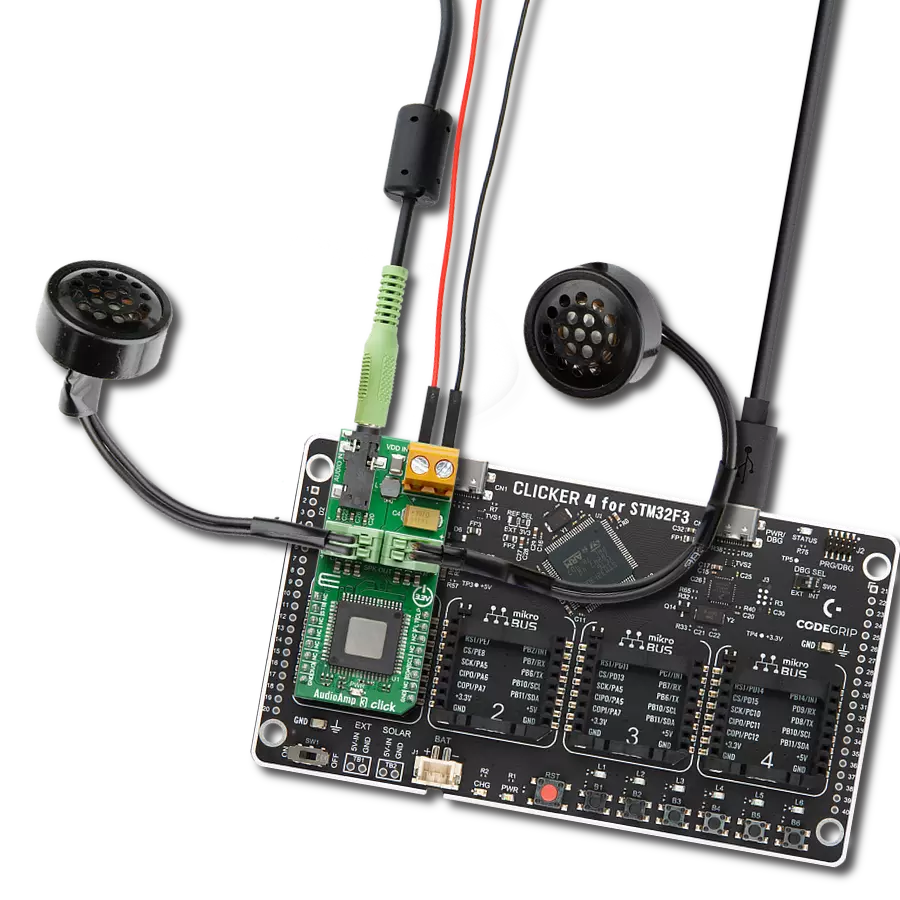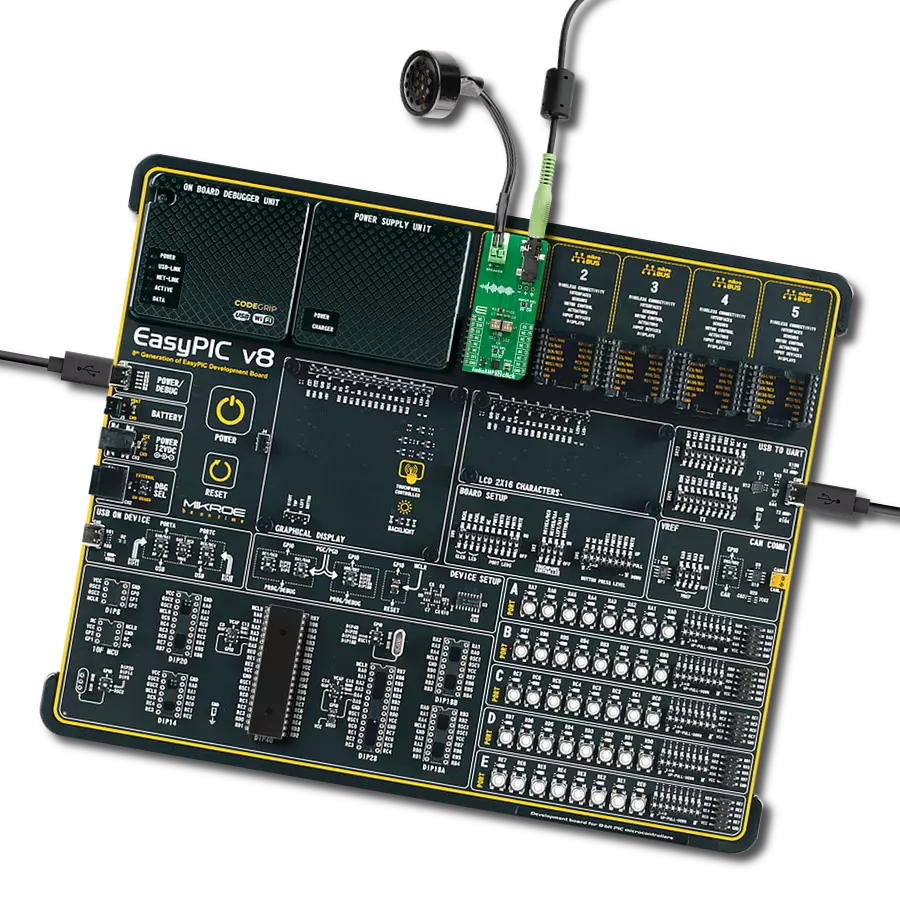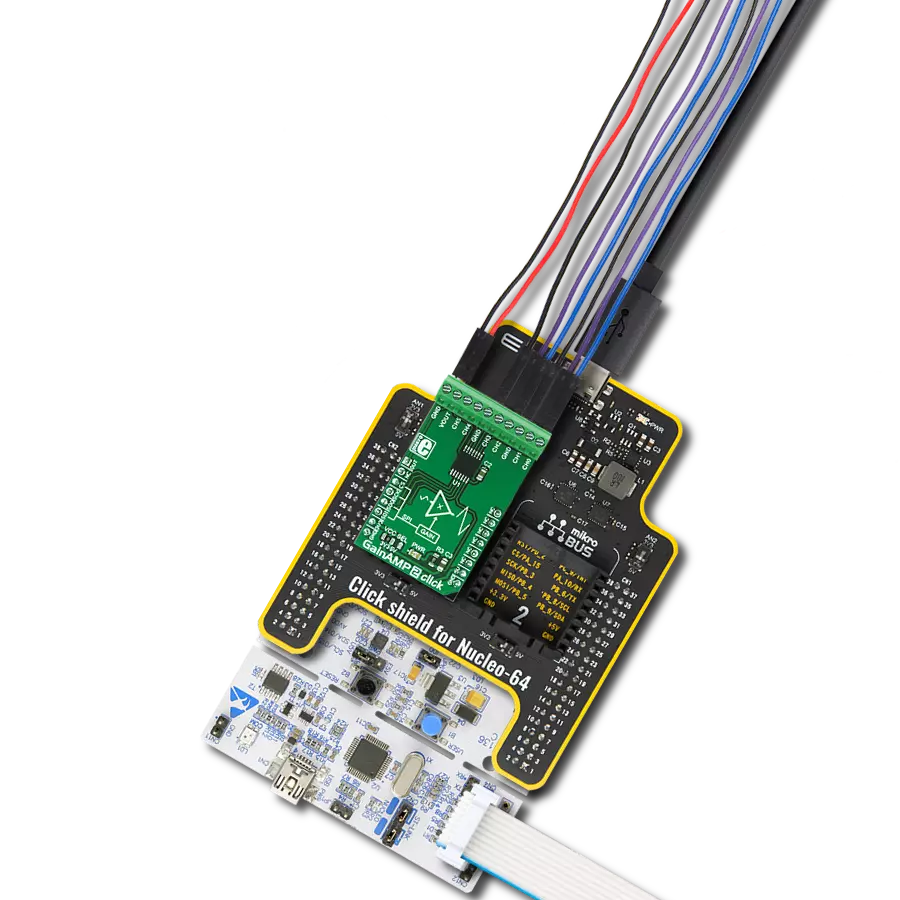Don't let poor audio quality hold you back. Add a stereo amplifier to your solution and unlock its full potential
A
A
Hardware Overview
How does it work?
AudioAmp Click is based on the LM48100Q-Q1, a Boomer™ mono, 1.3W audio power amplifier with output fault detection and volume control from Texas Instruments. It has an input mixer and multiplexer, high PSRR, short circuit and thermal protection, advanced click-and-pop suppression, and more. Dual audio input can be mixed/multiplexed to the device output with an independent 32-step volume control. The high power supply rejection ratio (PSRR) allows the device to operate in noisy environments without additional power supply conditioning. In addition, its superior click-and-pop suppression eliminates audible transients on power up/down and during a
shutdown. As mentioned, the LM48100Q-Q1 also features a comprehensive output fault detection system that senses the load conditions, protects the device during short circuit events, and detects open circuit conditions. There are two functional modes for fault diagnostics. In One-Shot mode, after performing the test sequence, enable diagnostic bit is ignored, and the test sequence will not be rerun. In Continuous diagnostic mode, the test sequence is repeated until the device is reset, taken out of this mode, or a fault condition occurs. The AudioAmp Click communicates with the host MCU using the standard I2C 2-Wire interface to read data and configure settings,
supporting a Fast mode operation up to 400KHz. The I2C address can be chosen over the ADDR selection jumper, with 0 selected by default. The fault conditions can be observed via the FLT pin of the mikroBUS™ socket, with a LOW logic state if a fault condition has occurred. This Click board™ can operate with either 3.3V or 5V logic voltage levels selected via the PWR SEL jumper. This way, both 3.3V and 5V capable MCUs can use the communication lines properly. However, the Click board™ comes equipped with a library containing easy-to-use functions and an example code that can be used, as a reference, for further development.
Features overview
Development board
PIC32MZ Clicker is a compact starter development board that brings the flexibility of add-on Click boards™ to your favorite microcontroller, making it a perfect starter kit for implementing your ideas. It comes with an onboard 32-bit PIC32MZ microcontroller with FPU from Microchip, a USB connector, LED indicators, buttons, a mikroProg connector, and a header for interfacing with external electronics. Thanks to its compact design with clear and easy-recognizable silkscreen markings, it provides a fluid and immersive working experience, allowing access anywhere and under
any circumstances. Each part of the PIC32MZ Clicker development kit contains the components necessary for the most efficient operation of the same board. In addition to the possibility of choosing the PIC32MZ Clicker programming method, using USB HID mikroBootloader, or through an external mikroProg connector for PIC, dsPIC, or PIC32 programmer, the Clicker board also includes a clean and regulated power supply module for the development kit. The USB Micro-B connection can provide up to 500mA of current, which is more than enough to operate all onboard
and additional modules. All communication methods that mikroBUS™ itself supports are on this board, including the well-established mikroBUS™ socket, reset button, and several buttons and LED indicators. PIC32MZ Clicker is an integral part of the Mikroe ecosystem, allowing you to create a new application in minutes. Natively supported by Mikroe software tools, it covers many aspects of prototyping thanks to a considerable number of different Click boards™ (over a thousand boards), the number of which is growing every day.
Microcontroller Overview
MCU Card / MCU
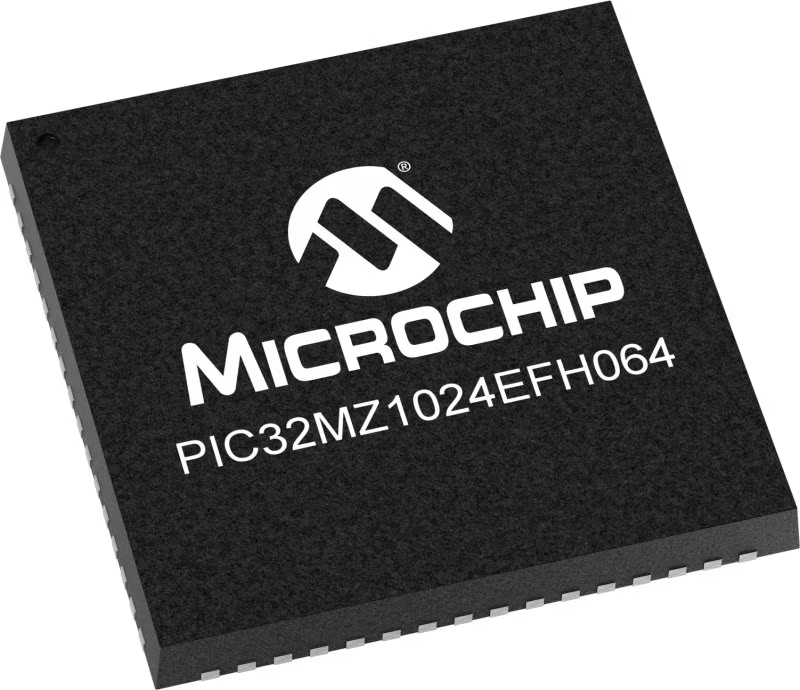
Architecture
PIC32
MCU Memory (KB)
1024
Silicon Vendor
Microchip
Pin count
64
RAM (Bytes)
524288
Used MCU Pins
mikroBUS™ mapper
Take a closer look
Click board™ Schematic

Step by step
Project assembly
Software Support
Library Description
This library contains API for AudioAmp Click driver.
Key functions:
audioamp_set_volume- Set mux volume functionaudioamp_set_volume_channel- Set channel volume functionaudioamp_set_normal_operation- Set normal opeation function
Open Source
Code example
The complete application code and a ready-to-use project are available through the NECTO Studio Package Manager for direct installation in the NECTO Studio. The application code can also be found on the MIKROE GitHub account.
/*!
* \file
* \brief AudioAmp Click example
*
* # Description
* AudioAmp Click is a stereo audio amplifier which can be controlled by using this
* Click driver.
*
* The demo application is composed of two sections :
*
* ## Application Init
* Performs driver and log module initialization, enables I2C, turns on the AudioAmp device
* and sends a message about init status.
*
* ## Application Task
* This is a example which demonstrates the use and control of the AudioAmp Click board.
*
* \author Nemanja Medakovic
*
*/
#include "board.h"
#include "log.h"
#include "audioamp.h"
static audioamp_t audioamp;
static log_t logger;
void application_init ( void )
{
log_cfg_t log_cfg;
/**
* Logger initialization.
* Default baud rate: 115200
* Default log level: LOG_LEVEL_DEBUG
* @note If USB_UART_RX and USB_UART_TX
* are defined as HAL_PIN_NC, you will
* need to define them manually for log to work.
* See @b LOG_MAP_USB_UART macro definition for detailed explanation.
*/
LOG_MAP_USB_UART( log_cfg );
log_init( &logger, &log_cfg );
log_info( &logger, "---- Application Init... ----" );
audioamp_cfg_t audioamp_cfg;
// Click initialization.
audioamp_cfg_setup( &audioamp_cfg );
AUDIOAMP_MAP_MIKROBUS( audioamp_cfg, MIKROBUS_1 );
if ( audioamp_init( &audioamp, &audioamp_cfg ) == AUDIOAMP_INIT_ERROR )
{
log_info( &logger, "---- Application Init Error. ----" );
log_info( &logger, "---- Please, run program again... ----" );
for ( ; ; );
}
log_info( &logger, "---- Application Init Done. ----" );
log_info( &logger, "---- Application Running... ----" );
log_info( &logger, "---- Check your audio speaker. ----\n" );
audioamp_power_on( &audioamp );
}
void application_task ( void )
{
log_info( &logger, "---- Volume level control testing... ----" );
audioamp_set_volume( &audioamp, AUDIOAMP_IN_1 | AUDIOAMP_IN_2, 5 );
Delay_ms ( 1000 );
Delay_ms ( 1000 );
Delay_ms ( 1000 );
audioamp_set_volume( &audioamp, AUDIOAMP_IN_1 | AUDIOAMP_IN_2, 15 );
Delay_ms ( 1000 );
Delay_ms ( 1000 );
Delay_ms ( 1000 );
audioamp_set_volume( &audioamp, AUDIOAMP_IN_1 | AUDIOAMP_IN_2, 25 );
Delay_ms ( 1000 );
Delay_ms ( 1000 );
Delay_ms ( 1000 );
audioamp_set_volume( &audioamp, AUDIOAMP_IN_1 | AUDIOAMP_IN_2, 32 );
Delay_ms ( 1000 );
Delay_ms ( 1000 );
Delay_ms ( 1000 );
log_info( &logger, "---- Volume level control test done. ----" );
log_info( &logger, "---- Input mute/unmute control testing... ----" );
audioamp_mute( &audioamp );
Delay_ms ( 1000 );
Delay_ms ( 1000 );
Delay_ms ( 1000 );
audioamp_unmute( &audioamp );
// 10 seconds delay
Delay_ms ( 1000 );
Delay_ms ( 1000 );
Delay_ms ( 1000 );
Delay_ms ( 1000 );
Delay_ms ( 1000 );
Delay_ms ( 1000 );
Delay_ms ( 1000 );
Delay_ms ( 1000 );
Delay_ms ( 1000 );
Delay_ms ( 1000 );
log_info( &logger, "---- Input mute/unmute control test done. ----" );
}
int main ( void )
{
/* Do not remove this line or clock might not be set correctly. */
#ifdef PREINIT_SUPPORTED
preinit();
#endif
application_init( );
for ( ; ; )
{
application_task( );
}
return 0;
}
// ------------------------------------------------------------------------ END
Additional Support
Resources
Category:Amplifier



















